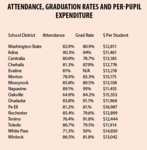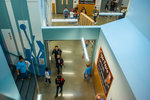


A week after students began hitting the books for the new school year, area school districts got a report card of their own showing test scores, attendance, graduation rates and more.
On Sept. 10, the Washington Office of the Superintendent of Public Instruction released the results of statewide testing in the 2018-2019 school year in its state Report Card.
Full results for each school district and individual school in the state are available at washingtonstatereportcard.ospi.k12.wa.us.
Data shows Adna and Napavine leading the pack of area districts overall. However, they also spend the least money per student, each lower than the state average as well.
The Adna School District, ranked first locally in attendance and English scores, spends $11,461 per student, more than $1,300 less than the state average.
Lisa Dallas, principal of Adna Elementary, said that was evidence of staff working to do the best with the funding they have available.
“I think in Adna you’ve got a staff that has really committed themselves to teaching and how to teach best,” she said. “I know that’s just a characteristic of all of teachers and staff.”
She said parents deserve credit for Adna’s high attendance rate.
“I’d also like to credit our parents and their involvement and their commitment to academic success and the value of that,” she said.
Napavine, which has the highest graduation rate in the area, according to OSPI’s statistics, and beat the state average both in math and English scores — the only area school to do so— spends even less, with $11,455 per student.
“I would love to be able to pinpoint it to any one prgram or one specific strategy,” said Napavine Superintendent Geoff Parks.
Instead, he attributed the district’s success to a collaborative relationship between teachers, parents and students. He said Lewis County districts in general do a good job at engaging with individual students to find their own “pathways to success.”
“The best way to do that is just having that mindset from every person on staff that we build relationships with our students and their parents first,” he said. “Our staff and our parents work so well together it makes my job real easy.”
According to the data, 82.9 percent of Washington’s 1.13 million students attend school regularly, 48.9 percent meet math standards and 59.6 percent meet English language arts standards. On average, $12,811 is spent on each student per year.
The state’s four-year graduation rate is 80.9 percent.
The results of the state assessments have remained stable, according to OSPI.
“Stability can be a double-edged sword,” said Chris Reykdal, superintendent of public instruction, in a press release. “On one hand, it means our educational system is maintaining the gains we have made. On the other, it means achievement gaps between student groups are continuing to persist.”
Several area school districts beat the states averages, while others lag behind in attendance, graduation rates and testing, according to the data.
Of districts in The Chronicle’s coverage area, Napavine had the highest four-year graduation rate, at 95 percent, with Adna close behind at 94 percent.
Superintendent James Forrest said Adna actually had a 100 percent graduation rate last, which wasn’t accurately reflected in the statistics.
“We’re really proud of our graduation rate,” he said.
White Pass had the lowest graduation rate, at just 50 percent.
Adna had the highest attendance rate, with just over 90 percent of students showing up regularly. About half the local school districts trended above the state average of 82.9 percent attendance, with Oakville bringing up the rear at 64.8 percent.
Mossyrock had the best math scores in the area, with 53.6 percent meeting state standards, and was closely followed by Napavine, at 52.5 percent and Rochester, at 52.2 percent.
Mossyrock also had the third-best graduation rate in the area, with 89.5 percent
“We’re little but we’re powerful,” said Superintendent Lisa Grant. “We are excited. We feel like things are moving together in the right direction.”
Grant said the district made some changes in math instruction and are happy to see the results. Being a small district, she said, also benefits Mossyrock.
“We have kids move in and out, but we see them often from kindergarten through graduation,” she said. “There’s that whole community buy-in.”
Meanwhile, Adna had the best English language arts scores, with 69.6% meeting standards — a full 10 percent higher than the state average.
“Our math is kind of our focus at the Middle/High School this year,” Forrest said.
Adna Middle/High School Principal Thad Nelson said that means adding more math instruction, primarily for sixth-grade students.
“They’re being ... double dosed in math,” he said. “We’re focussed on filling some gaps in learning and also challenging some students that are getting it.”
Five area schools met the math standards, and five met English standards.
Oakville brought up the low end of both, with 19.1 meeting math standards and 33.8 percent meeting English standards.
While top testers Adna and Napavine spent the least per student, Pe Ell, middle of the pack and close to the state average in most categories, spends $16,987 per student, the most in the area.
Other high-spending school districts include Oakville, at $15,353, Morton, at $15,175, and White Pass, at $14,830.